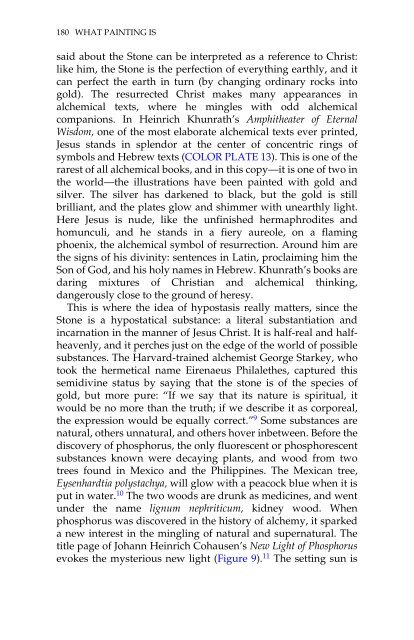What Painting Is: How to Think about Oil Painting ... - Victoria Vesna
What Painting Is: How to Think about Oil Painting ... - Victoria Vesna
What Painting Is: How to Think about Oil Painting ... - Victoria Vesna
Create successful ePaper yourself
Turn your PDF publications into a flip-book with our unique Google optimized e-Paper software.
180 WHAT PAINTING IS<br />
said <strong>about</strong> the S<strong>to</strong>ne can be interpreted as a reference <strong>to</strong> Christ:<br />
like him, the S<strong>to</strong>ne is the perfection of everything earthly, and it<br />
can perfect the earth in turn (by changing ordinary rocks in<strong>to</strong><br />
gold). The resurrected Christ makes many appearances in<br />
alchemical texts, where he mingles with odd alchemical<br />
companions. In Heinrich Khunrath’s Amphitheater of Eternal<br />
Wisdom, one of the most elaborate alchemical texts ever printed,<br />
Jesus stands in splendor at the center of concentric rings of<br />
symbols and Hebrew texts (COLOR PLATE 13). This is one of the<br />
rarest of all alchemical books, and in this copy—it is one of two in<br />
the world—the illustrations have been painted with gold and<br />
silver. The silver has darkened <strong>to</strong> black, but the gold is still<br />
brilliant, and the plates glow and shimmer with unearthly light.<br />
Here Jesus is nude, like the unfinished hermaphrodites and<br />
homunculi, and he stands in a fiery aureole, on a flaming<br />
phoenix, the alchemical symbol of resurrection. Around him are<br />
the signs of his divinity: sentences in Latin, proclaiming him the<br />
Son of God, and his holy names in Hebrew. Khunrath’s books are<br />
daring mixtures of Christian and alchemical thinking,<br />
dangerously close <strong>to</strong> the ground of heresy.<br />
This is where the idea of hypostasis really matters, since the<br />
S<strong>to</strong>ne is a hypostatical substance: a literal substantiation and<br />
incarnation in the manner of Jesus Christ. It is half-real and halfheavenly,<br />
and it perches just on the edge of the world of possible<br />
substances. The Harvard-trained alchemist George Starkey, who<br />
<strong>to</strong>ok the hermetical name Eirenaeus Philalethes, captured this<br />
semidivine status by saying that the s<strong>to</strong>ne is of the species of<br />
gold, but more pure: “If we say that its nature is spiritual, it<br />
would be no more than the truth; if we describe it as corporeal,<br />
the expression would be equally correct.” 9 Some substances are<br />
natural, others unnatural, and others hover inbetween. Before the<br />
discovery of phosphorus, the only fluorescent or phosphorescent<br />
substances known were decaying plants, and wood from two<br />
trees found in Mexico and the Philippines. The Mexican tree,<br />
Eysenhardtia polystachya, will glow with a peacock blue when it is<br />
put in water. 10 The two woods are drunk as medicines, and went<br />
under the name lignum nephriticum, kidney wood. When<br />
phosphorus was discovered in the his<strong>to</strong>ry of alchemy, it sparked<br />
a new interest in the mingling of natural and supernatural. The<br />
title page of Johann Heinrich Cohausen’s New Light of Phosphorus<br />
evokes the mysterious new light (Figure 9). 11 The setting sun is


